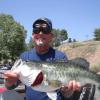If you dip in Minnwax poly acrylic twice, and sand after each coat with 220, you can get a smooth enough bait for painting.
I make larger baits, so fine detail isn't that critical.
When I first started painting, I would dip and sand, base coat with Createx flat white, and then paint with pearl white or silver, putting enough on to even out any rough spots that might be left.
Then any other shading colors, accents, and detail.
Finally, I would coat with epoxy, and let the epoxy give the final smooth finish.
Now, I don't sweat getting the bait too smooth.
I found that wood grain showing through the paint gives an added 3D effect to the paint job, so I don't even worry about sanding too smooth, or filling the wood grain any more. I just hit it with 220, round the edges, and, if there's any grain showing, so be it.



